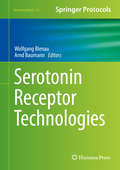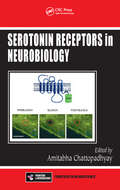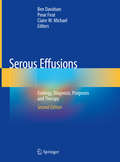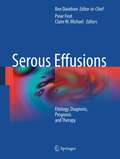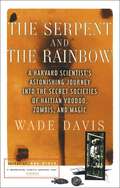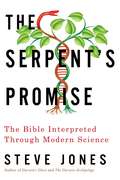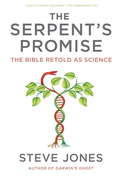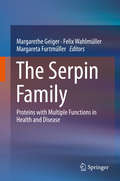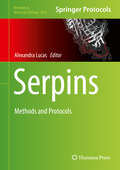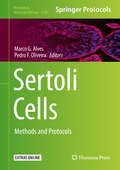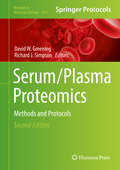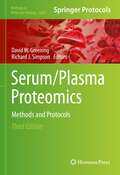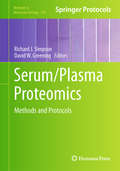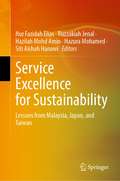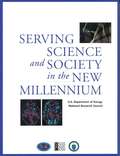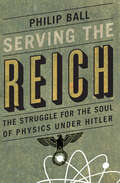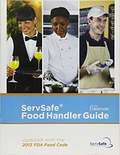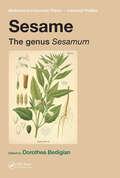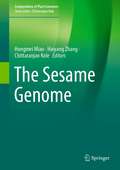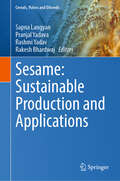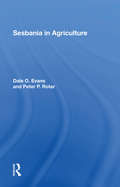- Table View
- List View
Serotonin Receptor Technologies
by Wolfgang Blenau Arnd BaumannReflecting a vast amount of new information concerning the functional characteristics of the various 5-HT receptor subtypes and the Na+-dependent serotonin transporter (SERT), this volume provides state of the art methodologies currently applied in serotonin research from leading experts in the field. Serotonin Receptor Technologies describes approaches that vary from molecular biological and biochemical techniques (e. g. , regarding receptor dimerization), fluorescence microscopy and imaging applications, flow cytometry, the use of organotypic slice and cell cultures to the generation of genetically modified animal models and the development of sophisticated behavioral tests, thus covering a wide spectrum of techniques to study serotonergic signaling in detail. Written for the popular Neuromethods series, chapters include the kind of detail and practical advice that ensures successful results in the lab. Authoritative and convenient, Serotonin Receptor Technologies serves to foster both basic and translational research aiming to further deepen our understanding of the various facets of aminergic systems, as well as to aid research on similar problems with related GPCRs and neurotransmitter transporters.
Serotonin Receptors in Neurobiology (Frontiers in Neuroscience)
by Amitabha ChattopadhyayA number of developments spanning a multitude of techniques makes this an exciting time for research in serotonin receptors. A comprehensive review of the subject from a multidisciplinary perspective, Serotonin Receptors in Neurobiology is among the first books to include information on serotonin receptor knockout studies. With contributions from l
Serous Effusions: Etiology, Diagnosis, Prognosis and Therapy
by Ben Davidson Pinar Firat Claire W. MichaelThis revised and updated second edition contains multiple microscopic illustrations of all diagnostic entities and ancillary techniques, providing a comprehensive, authoritative guide to all aspects of serous effusions. It now includes the many new antibodies which have been tested since the previous edition, as well as a discussion on next-generation sequencing and molecularly targeted therapy.Section one covers diagnosis for benign and malignant effusions while section two discusses biology, therapy, and prognosis highlighting clinical approaches that may be of value.Serous Effusions provides an indispensable guide to all aspects of current practice for cytopathologists, cytotechnicians, pathologists, clinicians and researchers in training and practice.
Serous Effusions
by Claire W. Michael Pinar Firat Ben DavidsonSerous (peritoneal, pleural and pericardial) effusions are a frequently encountered clinical finding in everyday medical practice and one of the most common specimen types submitted for cytological evaluation. The correct diagnosis of effusions is critical for patient management, as well as for prognostication and yet many clinicians find diagnosis and treatment of cancer cells in effusions very challenging. Featuring multiple microscopic illustrations of all diagnostic entities and ancillary techniques (immunhistochemistry and molecular methods), this book provides a comprehensive, authoritative guide to all aspects of serous effusions, including etiology, morphology and ancillary diagnostic methods, as well as data related to therapeutic approaches and prognostication. Section one covers diagnosis for benign and malignant effusions including the etiological reasons for the accumulation of effusions that provides the reader with the full spectrum of differential diagnoses at this anatomic site. Section Two discusses biology, therapy and prognosis highlighting clinical approaches that may be of value to patients and the movement towards personalized medicine and targeted therapy. Written by experts in the field internationally, Serous Effusions will provide an indispensible guide to all aspects of current practice for cytopathologists, cytotechnicians, pathologists, clinicians and researchers in training and practice.
The Serpent and the Rainbow: A Harvard Scientist's Astonishing Journey into the Secret Society of Haitian Voodoo Zombis and Magic
by Wade DavisA scientific investigation and personal adventure story about zombis and the voudoun culture of Haiti by a Harvard scientist.In April 1982, ethnobotanist Wade Davis arrived in Haiti to investigate two documented cases of zombis—people who had reappeared in Haitian society years after they had been officially declared dead and had been buried. Drawn into a netherworld of rituals and celebrations, Davis penetrated the vodoun mystique deeply enough to place zombification in its proper context within vodoun culture. In the course of his investigation, Davis came to realize that the story of vodoun is the history of Haiti—from the African origins of its people to the successful Haitian independence movement, down to the present day, where vodoun culture is, in effect, the government of Haiti’s countryside. The Serpent and the Rainbow combines anthropological investigation with a remarkable personal adventure to illuminate and finally explain a phenomenon that has long fascinated Americans.
The Serpent's Promise: The Bible Interpreted Through Modern Science
by Steve JonesFrom acclaimed geneticist Steve Jones, the story of the Bible as told through the lens of modern science. In The Serpent's Promise, Steve Jones retells many of the Biblical tales in the light of modern science. Are we all descended from a real-life Adam and Eve? Are some--or all--of us marked with the molecular equivalent of original sin, and if so what can we do about it? Was the Bible's great flood a memory of the end of the Ice Age? And what can science tell us of the mystical experiences reported by the faithful, or of the origin of faith itself? Some people deny the power of religious belief, others the findings of science. In this groundbreaking work from one of our great science writers, Steve Jones explores how these mysteries often overlap. He steps aside from the noisy debate between believers and non-believers to show how the questions that preoccupy us today are those of biblical times--and that science offers many of the answers. At once brilliantly erudite and highly readable, The Serpent's Promise is a witty and thoughtful account of the greatest scientific story ever told.
The Serpent's Promise
by Steve JonesA unique contribution to the God/religion debate: a scientific take on the Bible that doesn't take sides. Many of the subjects studied by physicists or by biologists are found in the texts of the world's religions: the origins of the universe, of life and of mankind; fate, sex, age and death; and the prospects of eternal life or of fiery doom. The Bible is a handbook for understanding Nature and, in its own way, it succeeds. As a factual account, of course, it is out of date, but many of its statements can be rephrased in modern terms. Distinguished geneticist Steve Jones has done that: written a rivetingly accessible work on recent advances in our understanding of ourselves, using the Bible as a framework. His narrative is structured around the Good Book's grand themes, from Genesis to Revelations, and weaves a series of unexpected facts into a coherent whole. The struggle of rationalism with its opposite has, after decades of torpor, returned to centre stage. Polemics against and in favour of religion and atheism fill the shelves. Instead of adding to that pile, Steve Jones stands back and take a fresh look at that issue in a volume that is not an attack or a defence but which explores scriptural motifs--Creation, the Garden of Eden, original sin, the Exodus, virgin birth, the Resurrection, and the Last Judgment--using the methods and results of the latest scientific research. It is a remarkably quick jump, shows Professor Jones, from Adam to astrophysics. Although some of the questions raised are beyond the capabilities of science, at least a scientist can ask them in a new way. Steve Jones shows there is a better route to understanding the universe than through doctrine.
The Serpin Family
by Margarethe Geiger Felix Wahlmüller Margareta FurtmüllerThe book provides an comprehensive overview on biology, genetics and cellular functions of serpins (serine protease inhibitors) in health and disease. With over 1000 members serpins are the most diverse family of protease inhibitors. Latest groundbreaking research findings are presented and broaden the understanding on inhibitory and non-inhibitory serpins, not only in mammalian organisms but also in insects, worms, plants and viruses.
Serpins: Methods and Protocols (Methods in Molecular Biology #1826)
by Alexandra LucasThis volume explores the latest methods used to study and define serpin molecular structure, basic protease inhibition, serpin targets, and the roles of serpin in biology and disease using animal models. The chapters in this book cover topics such as crystallography and phage display, peptide design, phospholipid binding, and thrombus formation to microbiome analysis and development. Written in the highly successful Methods in Molecular Biology series format, chapters include introductions to their respective topics, lists of the necessary materials and reagents, step-by-step, readily reproducible laboratory protocols, and tips on troubleshooting and avoiding known pitfalls.Cutting edge and authoritative, Serpins: Methods and Protocols is a valuable resource for researchers and scientists interested in learning more about this evolving field.
Sertoli Cells: Methods and Protocols (Methods in Molecular Biology #1748)
by Pedro F. Oliveira Marco G. AlvesThis detailed volume explores the use of Sertoli cells as models in male reproductive biology or as supporters for other cell types, and it answers the need for standardized protocols for their in vitro culture. Prepared for non-specialists as well as experienced researchers that may be interested in a multidisciplinary approach to study these cells, the book examines these remarkable cells that present some unique features that go far beyond the physical and nutritional support of spermatogenesis. Written for the highly successful Methods in Molecular Biology series, chapters include introductions to their respective topics, lists of the necessary materials and reagents, step-by-step, readily reproducible laboratory protocols, and tips on troubleshooting and avoiding known pitfalls. Authoritative and practical, Sertoli Cells: Methods and Protocols serves as a valuable resource for experienced researchers in reproductive biology, particularly andrologists, but also for future investigators and young students starting to study these extraordinary cells.
Serum/Plasma Proteomics
by David W. Greening Richard J. SimpsonBlood science has become a cornerstone of multiple disciplines, including clinical chemistry, disease diagnosis, and therapeutic monitoring. Over the past decade, we have witnessed the advent of increasingly powerful proteomics technologies that allow greater fundamental insights into the blood proteome. These technological improvements have, in part, fuelled the quest for the discovery of novel blood-based biomarkers of disease. Serum/Plasma Proteomics: Methods and Protocols is a comprehensive resource of protocols for areas, pre-analytical through to analytical, of plasma and serum proteomics. Divided into five convenient sections, this detailed volume covers fractionation strategies for in-depth blood proteome analysis, defined procedures for blood collection, handling and storage, detailed protocols for performing both antibody-based and non-antibody based quantitative assays, proteome analysis of blood cell compartments, circulating nanomebraneous vesicles and blood-related fluids, and finally data management, statistical design, and bioinformatic challenges. This book, contributed to by leading experts in the field, provides a valuable foundation for the development and application of blood-based proteomics. Written in the highly successful Methods in Molecular Biology(tm) series format, chapters contain introductions to their respective topics, lists of the necessary materials and reagents, step-by-step, readily reproducible laboratory protocols, and notes on troubleshooting and avoiding known pitfalls. Authoritative and easily accessible, Serum/Plasma Proteomics: Methods and Protocols, with its well-honed methodologies, seeks to serve both professionals and investigators new to the field in an effort to further our knowledge of this fundamental science.
Serum/Plasma Proteomics: Methods and Protocols (Methods in Molecular Biology #2628)
by David W. Greening Richard J. SimpsonThis third volume provides comprehensive protocols on pre-analytical, analytical, plasma, and serum proteomics. New and updated chapters are divided into nine sections, detailing blood processing and handling strategies, discovery- and targeted-based mass spectrometry, including workflows to aid in discovery and targeted data analysis, in addition to software and bioinformatics for the plasma proteome. This edition further integrates emerging areas in the development of technologies for plasma proteomics and assay platforms in biomarker discovery and translational proteomics, enrichment and detection strategies to understand the plasma proteome, and peptide, lipid and metabolite targeted assays. We also detail the emerging analysis of extracellular vesicles isolated from plasma. Written in the format of the highly successful Methods in Molecular Biology series, each of the 33 chapters includes an introduction to the topic, lists necessary materials and methods, includes hints and tips on troubleshooting and known pitfalls, and step-by-step, readily reproducible protocols. Authoritative and cutting-edge, Serum/Plasma Proteomics: Methods and Protocols, Third Edition aims to be comprehensive guide for researchers.
Serum/Plasma Proteomics
by David W. Greening Richard J. SimpsonBlood science has become a cornerstone of multiple disciplines, including clinical chemistry, disease diagnosis, and therapeutic monitoring. Over the past decade, we have witnessed the advent of increasingly powerful proteomics technologies that allow greater fundamental insights into the blood proteome. These technological improvements have, in part, fuelled the quest for the discovery of novel blood-based biomarkers of disease. Serum/Plasma Proteomics: Methods and Protocols is a comprehensive resource of protocols for areas, pre-analytical through to analytical, of plasma and serum proteomics. Divided into five convenient sections, this detailed volume covers fractionation strategies for in-depth blood proteome analysis, defined procedures for blood collection, handling and storage, detailed protocols for performing both antibody-based and non-antibody based quantitative assays, proteome analysis of blood cell compartments, circulating nanomebraneous vesicles and blood-related fluids, and finally data management, statistical design, and bioinformatic challenges. This book, contributed to by leading experts in the field, provides a valuable foundation for the development and application of blood-based proteomics. Written in the highly successful Methods in Molecular BiologyTM series format, chapters contain introductions to their respective topics, lists of the necessary materials and reagents, step-by-step, readily reproducible laboratory protocols, and notes on troubleshooting and avoiding known pitfalls. Authoritative and easily accessible, Serum/Plasma Proteomics: Methods and Protocols, with its well-honed methodologies, seeks to serve both professionals and investigators new to the field in an effort to further our knowledge of this fundamental science.
Serval Cats (Nature's Children)
by Tim CookeDescribes the physical features, habits and habitat of this one of the larger of the small wild cats.
Service Excellence for Sustainability: Lessons from Malaysia, Japan, and Taiwan
by Nur Fazidah Elias Ruzzakiah Jenal Hazilah Mohd Amin Hazura Mohamed Siti Aishah HanawiThis book provides significant conceptual and empirical contributions to the understanding of service science and the practices of service sectors in the wake of the fourth industrial revolution bringing together a collection of articles written by keynote and invited speakers at the 2nd Service Science Symposium held on 24 November 2019. The symposium was organised by the Serviceology Society Malaysia (SESMA), which aims to bring service researchers and practitioners under one roof to redefine service concepts and ideas and explore their application in real industrial and community settings. In their contributions, authors present multiple real-world cases of service systems to demonstrate how organisations can incorporate service science to achieve sustainable development. By re-examining the existing service science models and the value creation process using valuable insights obtained from industries and communities in Malaysia, Japan and Taiwan, the authors present a new way forward for organisations.
Serving Science and Society in the New Millenium
by U. S. Department of Energy StaffThe National Academies Press (NAP)--publisher for the National Academies--publishes more than 200 books a year offering the most authoritative views, definitive information, and groundbreaking recommendations on a wide range of topics in science, engineering, and health. Our books are unique in that they are authored by the nation's leading experts in every scientific field.
Serving the Reich: The Struggle for the Soul of Physics under Hitler
by Philip BallThis historical analysis of Heisenberg, Planck, Debye, and other German physicists during WWII &“is a stunning cautionary tale, well researched and told&” (Choice). After World War II, most scientists in Germany maintained that they had been apolitical or actively resisted the Nazi regime, but the true story is much more complicated. In Serving the Reich, Philip Ball takes a fresh look at that controversial history, contrasting the career of Peter Debye, director of the Kaiser Wilhelm Institute for Physics in Berlin, with those of two other leading physicists in Germany during the Third Reich: Max Planck, the elder statesman of physics, and Werner Heisenberg, who succeeded Debye as director of the institute when it became focused on the development of nuclear power and weapons. Mixing history, science, and biography, Ball offers a powerful portrait of moral choice and personal responsibility, as scientists navigated &“the grey zone between complicity and resistance.&” Ball&’s account of the different choices these men made shows how there can be no clear-cut answers or judgement of their conduct. Yet he also demonstrates that the German scientific establishment as a whole mounted no serious resistance to the Nazis, and in many ways acted as a willing instrument of the state. Serving the Reich considers what this problematic history can tell us about the relationship between science and politics today. Ultimately, Ball argues, a determination to present science as an abstract inquiry into nature that is &“above politics&” can leave science and scientists dangerously compromised and vulnerable to political manipulation. A CHOICE Outstanding Academic Title Award winner
ServSafe Coursebook
by National Restaurant AssociationDelivering comprehensive training of key food safety concepts, SERVSAFE COURSEBOOK is the ideal solution for the academic setting, multiple-day training or individuals in need of more extensive food safety training. <p><P>The content in ServSafe Coursebook goes beyond the principles found in ServSafe Manager Book (formerly Essentials) and adds greater depth and breadth of food safety practices by featuring expanded sections on food defense, high-risk populations, active managerial control, and crisis management.
ServSafe Coursebook
by National Restaurant Association Educational FoundationThe information presented in the Course is provided for general educational and informational pur¬poses only and is not intended to provide legal, business or risk management advice to any party, and in no way represents advice with respect to specific practices of any party. Parties who develop policies and procedures based upon the materials in the Course are urged to obtain the advice and guidance of legal counsel with respect to their practices and local laws. Although the Association Entities endeavor to include accurate and current information compiled from sources believed to be reliable, the Asso¬ciation Entities and their affiliates, distributors, and agents make no representations or warranties as to the accuracy, currency, or completeness of the information in or available through the Course. THE INFORMATION IN OR AVAILABLE THROUGH THE COURSE IS PROVIDED "AS IS" WITHOUT WARRANTY OF ANY KIND, EITHER EXPRESS OR IMPLIED, INCLUDING BUT NOT LIMITED TO THE IMPLIED WAR¬RANTIES OF MERCHANTABILITY, FITNESS FOR A PARTICULAR PURPOSE, OR NON-INFRINGEMENT.
ServSafe CourseBook 7th Edition
by National Restaurant Association<P>Congratulations! By opening this book, you are joining millions of foodservice professionals in taking the first step in a commitment to food safety.<P> ServSafe® training helps you understand all of the food safety risks faced by your operation. <P>Once you're aware of these risks, you can find ways to reduce them.
Servsafe Food Handler Guide: Updated with the 2013 FDA Food Code
by National Restaurant National Restaurant AssociatioThe ServSafe Food Handler Guide 6th Edition easily integrates food safety into any existing onboarding training program. Sections can be completed in approximately 10 minutes. Color-coded sections for easy reference. Color photographs from the learners point of view helps reinforce food safety concepts <p><p> Enhanced assessment can be taken at the completion of training to measure if employees have the minimum competency in food safety knowledge.
Sesame: The genus Sesamum (ISSN)
by Dorothea BedigianThe first comprehensive review of sesame and its close relative, Sesame: the genus Sesamum covers ethnographic data, modern use, linguistic analysis of sesame names from around the world, market size, export and import data, geographical sources, use in the food and cosmetic industries, and much more. The book includes a historical review of the genus Sesamum that reveals its place in present-day traditions and cultivation in Africa and Asia. Expanding coverage from archaeological and anthropological literature from India, Mesopotamia, and Egypt, this ethnobotanical monograph draws on folk sources, reviews the phytochemistry of Sesamum, and presents extensive references.
The Sesame Genome (Compendium of Plant Genomes)
by Hongmei Miao Haiyang Zhang Chittaranjan KoleThis book is the first comprehensive compilation of deliberations on whole genome sequencing of sesame including genome assembly, annotation, structure and synteny analysis, and sequencing of its chloroplast genome and also its wild species. It presents narratives on classical genetics and breeding, tissue culture and genetic transformation, molecular mapping and breeding. Other chapters describe the beneficial components in sesame protein and oil, botanical depictions and cytological features. Prospects of designed breeding in the post-genomics era including gene discovery have also been enumerated.Altogether, the book contains 19 chapters authored by globally reputed experts on the relevant field in this crop. This book is useful to the students, teachers, and scientists in the academia and relevant private companies interested in classical and molecular genetics, biotechnology, breeding, biochemistry, traditional and molecular breeding, and structural and evolutionary genomics. The work is also useful to seed and oil industries.
Sesame: Sustainable Production and Applications (Cereals, Pulses and Oilseeds)
by Sapna Langyan Pranjal Yadava Rashmi Yadav Rakesh BhardwajThis edited book systematically discusses the advances in biotechnology, agrotechnology, and food technology in shaping sesame production, cultivation and uses to meet the future needs. Sesame (Sesamum indicum) is the oldest oilseed crop known to humans. It has been recognized as one of the most nutritious and health-supportive crops, with several applications in food, cosmetics, and health products. A wide variety of sesame is grown throughout the world, primarily in Asia and Africa. It’s seed and seed oil is being used widely in diverse cuisines. It is also used in cosmetic and health products. Advances in biotechnology, agrotechnology, and food technology in redefining sesame production and uses are of great importance. Various new advanced technologies have been employed to develop high yielding and disease resistant sesame varieties, for better cultivation, seed production, and for utilization of seeds and seed oil in a lot of foods, cosmetic, and health products. This book provides an overview of different advanced technologies, their mechanisms, and their effect on the quality of the sesame crop and sesame seeds/oil. The book also emphasizes the assessment of advanced technology on its limitations and advantages. This book offers the latest research on techniques, applications, and challenges of producing quality sesame crop with recommendations towards sustainable agriculture. The book is a valuable resource for students, researchers and scientists working in the field of sesame production and applications. Industry experts involved in development and management of sustainable production technologies will also find the book beneficial.
Sesbania In Agriculture
by Dale O. Evans Peter P RotarSesbania, a member of the legume family, has been the object of study in new efforts to discover, conserve, and use plant genetic resources. This volume brings together the most recent research on the subject and combines it with previous studies and an extensive review of the literature. This work is a synthesis of biological description and applied studies related to the highly variable and versatile Sesbania species. Sesbania occurs in both annual and perennial forms in tropical and subtropical regions and is adaptable to an unusually wide variety of soil conditions, including saline. The most important uses of the plants are in nitrogen fixation (as in green manures) and in cropping systems. Auxiliary uses of the different species are as sources for pulp fibers, fuel wood, animal fodder, and wind-breaks.
